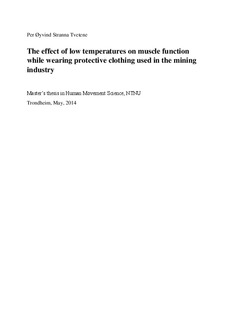| dc.contributor.advisor | Beekvelt, Mireille van | nb_NO |
| dc.contributor.advisor | Færevik, Hilde | nb_NO |
| dc.contributor.advisor | Wiggen, Øystein | nb_NO |
| dc.contributor.author | Tvetene, Per Øyvind Stranna | nb_NO |
| dc.date.accessioned | 2014-12-19T14:22:09Z | |
| dc.date.available | 2014-12-19T14:22:09Z | |
| dc.date.created | 2014-08-13 | nb_NO |
| dc.date.issued | 2014 | nb_NO |
| dc.identifier | 737572 | nb_NO |
| dc.identifier.uri | http://hdl.handle.net/11250/264309 | |
| dc.description.abstract | The purpose of this study was to investigate how muscle function is affected by cold environments in persons wearing cold protective clothing for the mining industry when performing work-related tasks. 15 subjects were exposed to a low temperature (-15°C) and a moderate temperature (5°C). Protective clothing was similar during both environmental conditions. The subjects performed a total of five test periods and four work periods. A test period consisted of dynamic wrist flexion and maximal voluntary contractions for wrist flexion, elbow flexion and shoulder abduction. Work periods consisted of three tasks; 1) arms above head, 2) arms at hip height and 3) lifting dumbbells of the floor and onto a case. Cold exposure led to lower skin temperatures and higher muscle activity in the wrist flexors during the work period compared to 5°C. In addition, we observed a reduced amount of local oxygenation in the wrist flexors in the cold. In conclusion, cold exposure reduced skin temperatures, which further led to minor negative effect on muscle function. | nb_NO |
| dc.language | eng | nb_NO |
| dc.publisher | Norges teknisk-naturvitenskapelige universitet, Det medisinske fakultet, Institutt for nevromedisin | nb_NO |
| dc.title | The effect of low temperatures on muscle function while wearing protective clothing used in the mining industry | nb_NO |
| dc.type | Master thesis | nb_NO |
| dc.contributor.department | Norges teknisk-naturvitenskapelige universitet, Det medisinske fakultet, Institutt for nevromedisin | nb_NO |
